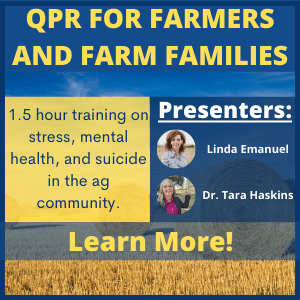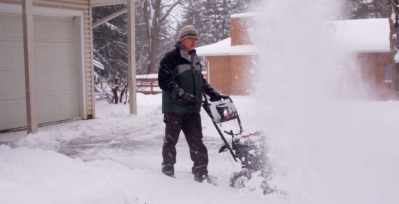Last updated on July 24th, 2024 at 09:51 am
Farmers and ranchers risk injury from slips, trips, and falls every day due to the varied types of work and surfaces involved in their day. They work with hand tools, ladders, large equipment, concrete and wooden steps, rough and uneven walking surfaces that can also be wet, icy, oily, and slippery, and have multiple trips from outside light into darkened facility areas. Tripping hazards can cause same level but serious falls. Some of these may include cords, debris on shop floors, feed sacks, worn floor mats, and small object left on the floor or ground. Low level falls include various types of equipment, horses, fences, and many others. High level falls (over 10 feet) include roof tops, hay mows, large equipment. These can be mitigated by keeping walkways well lit, step rises in good repair, secure handrails, and ladders regularly check for safe handholds and step rungs.
Human factor safety measures include the following:
- Use handrails when they are available.
- Follow the 3 points of contact rule. Use 2 hands and one foot or two feet and one hand when mounting and dismounting ladders of all kinds. This includes free standing, those attached to bins, and tractor and combine ladders. Always face the ladder!
- When handling animals, be aware of the flight zones and use correct technique with lead ropes and lunge lines.
- Wear gloves that are the right size and appropriate for the job.
- Check footwear on a regular basis to make sure the grips and water channels have not worn down. With the exception of chemical use or heavy wet environments, leather work boots with sturdy, flat soles with intact boot laces are a necessary part of farm work. An exception includes when working with horses where a heeled boot is needed or work in very wet areas such as milking parlors, power washing, and pesticide applications where a rubber or nitrile boot is the safe option.
- When moving from an outdoor light or well lit room to a darker area, remember to remove sunglasses or pause a few second before entering in case there is a step up or down.
- Avoid carrying loads that are so high or too bulky that they block your line of vision.
- Keep walkways picked and swept up.
- Avoid distracting conversations such as cell phone use when engaged in work areas that can be hazardous.
Data
Webinars
| Webinar Title | Summary | Link |
|---|---|---|
| Agricultural All-Terrain Vehicle Safety | All-terrain vehicle (ATV) crashes are one of the leading causes of death and injuries in the agriculture industry in the United States. In this presentation, we will evaluate the current situation and possible solutions related to agricultural ATV safety. Potential injury preventative actions were evaluated based on the hierarchy of control, including elimination or substitution, engineering control, administrative authority, training, and personal protective equipment. | |
| ATV Safety | ATVs (all-terrain vehicles) are one of the most common and dangerous pieces of equipment on today’s farm. An average of 500 persons die and another 100,000 are seriously injured each year while operating ATVs. Nearly 60% of the fatalities occur in agriculture. This course teaches how to recognize, evaluate, and control common hazards when operating an ATV on the farm. Spanish Title: Seguridad en ATV (Vehículos Todo Terreno) | |
| ATV-UTV Safety for Women | Agriculture ranks among the most hazardous industries. Farmers are at very high risk for fatal and nonfatal injuries, and farming is one of few industries in which family members (who often share the work and live on the premises) are also at risk for fatal and nonfatal injuries. ATVs and UTVs are found on all types of farms; they are useful for agricultural work, but they also pose serious hazards to operators and passengers. Studies indicate that injured ATV/UTV passengers are more commonly female and youth and that helmet use is significantly lower for passengers. The focus of the training would be on ATV/UTV maintenance and safety features, personal protective equipment (PPE), load and weight considerations, operation on public roadways, as well as employee training and considerations for working alone. | |
| Chainsaw Safety Training | The Chainsaw Safety training program is intended for workers and managers in the agricultural and forestry industries. The major focus of the program is on the identification of and the safe operation of chainsaws. According to the Centers for Disease Control and Prevention (CDC), approximately 36,000 people are injured by chainsaws annually. | |
| Crashes Involving Agricultural Vehicles in the Southwest Region | Motor vehicle crashes are among the top reasons that workers are injured in agriculture. From an occupational safety and health perspective, rural roadways present unique challenges to stakeholders engaged in crash and injury prevention. This session provides an overview of the key issues relevant to rural roadway safety within the context of agricultural vehicles and logging trucks and proven methods for reducing rural roadway crashes and their severity. In addition, the magnitude of the crash problem and trends will be presented for the Southwest Region (i.e., AR, LA, NM, OK, and TX) using data from the Southwest Agricultural Crash Surveillance System (SW AgCRASH). | |
| Discovering the Root of your Back Story: Prevention and Understanding of Back Injuries (December 10, 2020) | Back injuries are one of the most common forms of farm-related injuries, so protecting the back is one of the most important things a producer can do to stay active on the farm. Men and women are both prone to work-related back pain and the first episode usually occurs between the ages of 20 and 40. Training will focus on effects of whole body vibration, causes of back injuries/pain, how to prevent back injuries/pain, and other considerations. | |
| Ergonomic Safety for Farm Women (December 1, 2020) | It is no secret – women are playing an increased role in production agriculture. They account for about one-third of the management, ownership and work on farms, ranches and in crop production. A major challenge continues to be access to protective equipment that meets the ergonomic needs of women. This program is intended to help women in rural/agricultural communities identify ergonomic issues leading to musculoskeletal injuries in farm and ranch work and discover resources to aid in injury prevention. | |
| Hearing Loss Prevention for Forest Workers | Hearing loss is common, especially among workers who are exposed to hazardous noise where they work. Forestry and Logging are among the top industry sectors for worker exposure to hazardous noise that can contribute to hearing loss. According to The National Institute for Occupational Safety and Health (NIOSH), noise-exposed workers in Forestry and Logging had a higher percentage of hearing loss (21%) than all noise-exposed industries combined (19%). This training will discuss effective methods for preventing hearing loss from noise in … | |
| Musculoskeletal and Ergonomic Safety for Forest Workers | Forest workers face unique ergonomic challenges due to their exposure to extreme environmental conditions, heavy workload, and dangerous tools and machines. The forest sector has one of the highest rates of Musculoskeletal Disorders (MSDs), almost 100 times higher than the industrial targets the National Institute for Occupational Safety & Health (NIOSH) set. This program is intended to help forest workers identify ergonomic issues leading to musculoskeletal injuries and discover resources to aid in injury treatment and prevention. | |
| Pediatric Farm-Related Injuries: Safeguarding Children Who Visit or Live on Farms | Injuries are the most common cause of death for children and adolescents, and farms and ranches present many unique hazards to youth. During this presentation, we will discuss many of these including augers, grain bins, gravity boxes, tractors, power take-offs (PTOs), manure pits, chemical exposures, animals, and gasoline-powered pressure sprayers. One of the most common causes of serious injuries and deaths to youth on farms and ranches are the use of off-road vehicles (ORVs) like all-terrain vehicles (ATVs), utility task vehicles (UTVs), and recreational off-highway vehicles (ROVs). The safety concerns and prevention strategies related to ORVs will be a featured segment of the presentation. A general overview of how the growth and development of youth affect the risk of injury, and the role healthcare providers can assume to impact injury prevention will be discussed. | |
| Planting the Seeds of Tractor and Machinery Safety | Tractors and machinery have traditionally been a leading cause of fatal and nonfatal injuries on and around farms and ranches. The Planting the Seeds of Tractor and Machinery Safety webinar will cover the basic hazards associated with agricultural tractors and machinery and how to prevent injuries from these hazards. | |
| Prevention of Grain Dust Explosions | This Grain Safety program is intended for workers and managers in the grain industry including grain elevators, farm operators and workers, grain haulers, and agriculture business owners. The major focus of the program is on safety in confined space work areas including entry, respiratory protection, and prevention of Grain Dust explosions. | |
| Protecting and Promoting the Health of Young Agricultural Workers: The Role of Employers and Supervisors | There are many benefits for hiring youth in agriculture, including the development of job skills, increased self-esteem, responsibility, and earned income. However, adolescents and young adults working in agriculture (under 25 years old) are at increased risk for occupational injuries. In addition to traditional workplace hazards, developmental differences (both physical and cognitive), inexperience, fatigue, and distracted behaviors increase the risk of injury. Employers and supervisors play an active role in protecting these workers. Communicating effectively with young workers about health and safety hazards that impact injury risk is key to protecting this population. This webinar will describe specific skills and practices that can be implemented in the workplace, on family farms, and in agricultural classrooms. | |
| Rural Road Safety: A Shared Responsibility | Rural roads play an important role in moving people and goods in the U.S., but all too often, crashes occur, and fatalities happen. These fatalities are not just statistics, but are our loved ones and community members, so how do we proactively work to reach zero? In this webinar, we will examine the concept that rural road safety is a shared responsibility, discuss safety culture, and delve into some strategies that can be used to improve safety for all rural road users. You will leave this webinar with actions you as an individual can take to make a difference. | |
| The Ergonomics of Hand Planting Reforestation Work | Reforestation work is vital to the health of America’s forests and the U.S. economy. Hand planting, a common reforestation practice, provides unique challenges to safety and health practitioners interested in reducing occupational injuries and illnesses. This webinar will share lessons learned from a team of investigators studying occupational exposures to physical risk factors among hand planters in the Southeastern United States. | |
| Understanding the Tractor Factor | Agricultural tractors have traditionally been a leading cause of fatal and nonfatal injuries on and around farms and ranches. this webinar will cover the basic hazards associated with agricultural tractors with their use both on and off the roadway and how to prevent these injuries. | |
| What’s New in Tractor and Agricultural Vehicle Safety | Tractors have traditionally been a leading cause of fatal and nonfatal injuries on and around farms and ranches. Other agricultural vehicles are adding to this trend. This webinar will cover the basic hazards associated with agricultural tractors and agricultural vehicles and how to prevent injuries from these hazards. |
Websites
- Agricultural Safety and Health Program at Ohio State University Extension
- Plan. Provide. Train. from OSHA
- Wounds and Injuries from MedlinePlus
Page updated: August 2022


